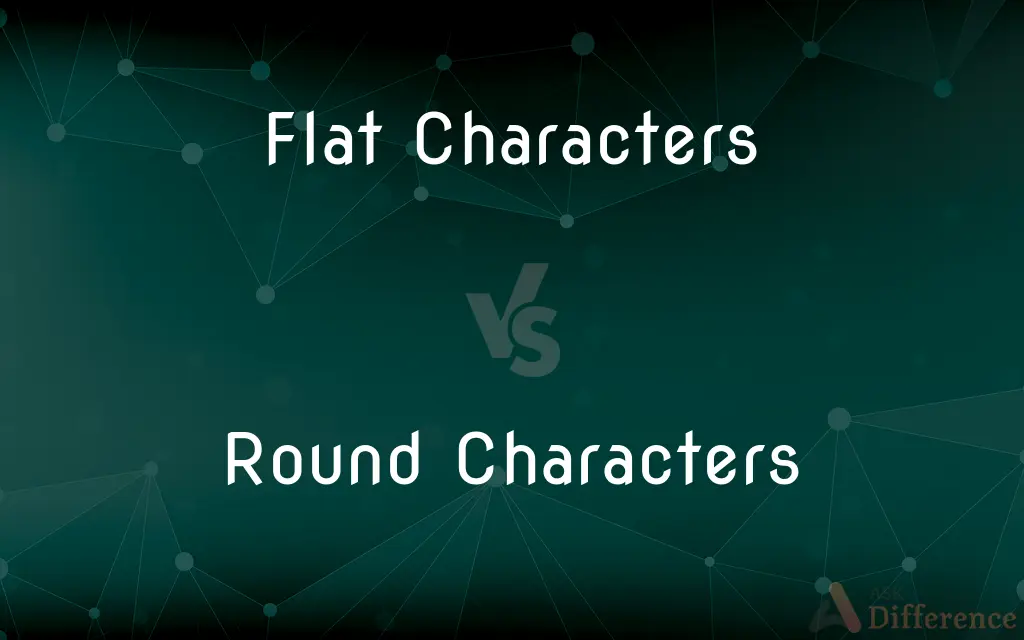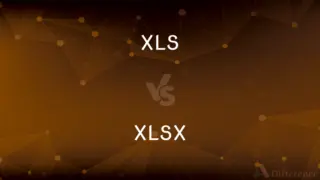Flat Characters vs. Round Characters — What's the Difference?
Edited by Tayyaba Rehman — By Fiza Rafique — Published on December 21, 2023
Flat Characters are two-dimensional with limited development, while Round Characters are complex with depth and evolution. Both play vital roles in storytelling.

Difference Between Flat Characters and Round Characters
Table of Contents
ADVERTISEMENT
Key Differences
Flat Characters and Round Characters are classifications in literature that speak to the depth and complexity of fictional individuals. Flat Characters, as the term suggests, are more one-dimensional, typically with straightforward, unchanging personalities or characteristics. They serve a specific purpose in the narrative, often to support the main plot or main characters. Their predictability can often be an asset to the storyline, ensuring a consistent reaction or behavior in various scenarios.
Conversely, Round Characters offer a richer reading experience, marked by their multi-faceted personalities, growth, and development. These characters undergo transformation, have multiple motivations, and are susceptible to internal conflicts. Round Characters, given their complexity, often remind readers of real people because of the depth of their emotions and unpredictability. They react differently under different circumstances, and this dynamism captivates readers, drawing them into the character's journey.
Interestingly, the presence of Flat Characters and Round Characters in a story provides balance. While Flat Characters move the story along, ensuring predictability and stability, Round Characters introduce change, challenges, and emotional depth. Think of Flat Characters as the supporting cast, setting the stage for Round Characters to shine in their full complexity.
In storytelling, neither type is superior to the other. Both Flat Characters and Round Characters serve critical roles in propelling a narrative. Their presence enriches the tapestry of the story, providing both predictability and surprise, stability and chaos, simplicity and depth.
Comparison Chart
Complexity
Simplistic and predictable
Complex with depth
ADVERTISEMENT
Character Development
Little to none
Undergoes development or transformation
Representation
Two-dimensional
Multi-dimensional
Role in Narrative
Supports main plot or characters
Central to the plot, undergoes change
Emotional Depth
Limited emotional range
Wide range of emotions and internal conflicts
Compare with Definitions
Flat Characters
Supporting cast with predictable reactions.
The teacher was a Flat Character, always strict and authoritative.
Round Characters
Multi-dimensional beings in stories.
The anti-hero was a Round Character, battling internal conflicts.
Flat Characters
Simplistic characters without development.
The cashier in the story remained a Flat Character, only serving customers.
Round Characters
Characters with depth and varied motivations.
The queen, a Round Character, juggled duty and personal desires.
Flat Characters
Two-dimensional individuals in narratives.
The villain's henchmen were Flat Characters, always following orders.
Round Characters
Central figures driving the narrative's change.
The detective, a Round Character, changed his beliefs as clues unraveled.
Flat Characters
Fictional beings with limited emotional depth.
In the tale, villagers were Flat Characters, always cheerful and welcoming.
Round Characters
Complex characters undergoing transformation.
The protagonist, a Round Character, evolved from timid to courageous.
Flat Characters
Characters with static, unchanging roles.
The loyal butler, a Flat Character, consistently attended to the protagonist's needs.
Round Characters
Fictional individuals reminiscent of real people.
The novel's sister was a Round Character, facing real-world dilemmas.
Common Curiosities
Can Flat Characters become Round Characters?
Yes, with narrative development, Flat Characters can evolve into Round Characters.
How do Round Characters differ?
Round Characters are complex, evolving, and exhibit a range of emotions and motivations.
Are Flat Characters unimportant in stories?
No, they play vital roles, often supporting the main narrative or characters.
Are Round Characters always protagonists?
No, while often central, Round Characters can also be secondary figures with depth.
Which character type undergoes transformation?
Round Characters often experience significant growth or change.
Do stories need both character types?
Not necessarily, but a mix can add depth and variety to a narrative.
Can a story have only Round Characters?
Yes, though it might lead to a very intricate narrative.
Is it easier to write Flat Characters?
Often, as they require less development and depth than Round Characters.
What are Flat Characters?
Flat Characters are simplistic, two-dimensional individuals in stories with limited development.
Are Flat Characters always predictable?
Generally, yes, they have consistent traits and reactions.
Can a Round Character become flat?
It's rare, but if a once-complex character becomes static, they might appear "flat."
Why are Round Characters captivating?
Due to their depth, unpredictability, and emotional range, readers can relate to or be intrigued by them.
Why are these terms "flat" and "round" used?
They metaphorically represent the depth (or lack thereof) and complexity of characters in narratives.
Can main characters be Flat Characters?
Yes, though it's less common as central figures often have more depth.
Are sidekicks typically Flat Characters?
Often, but not always. Some sidekicks can have depth and development.
Share Your Discovery

Previous Comparison
Reticulate Venation vs. Parallel Venation
Next Comparison
XLS vs. XLSXAuthor Spotlight
Written by
Fiza RafiqueFiza Rafique is a skilled content writer at AskDifference.com, where she meticulously refines and enhances written pieces. Drawing from her vast editorial expertise, Fiza ensures clarity, accuracy, and precision in every article. Passionate about language, she continually seeks to elevate the quality of content for readers worldwide.
Edited by
Tayyaba RehmanTayyaba Rehman is a distinguished writer, currently serving as a primary contributor to askdifference.com. As a researcher in semantics and etymology, Tayyaba's passion for the complexity of languages and their distinctions has found a perfect home on the platform. Tayyaba delves into the intricacies of language, distinguishing between commonly confused words and phrases, thereby providing clarity for readers worldwide.












































